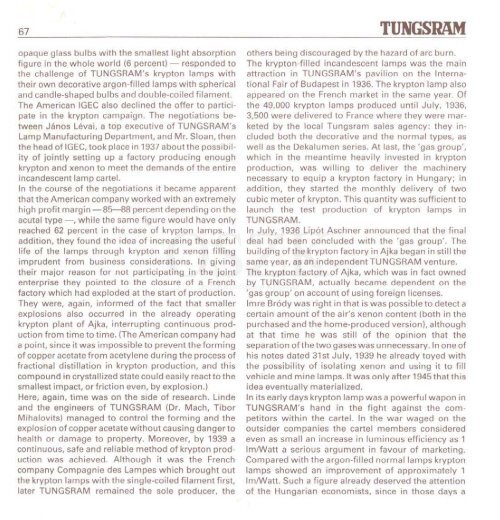THE HISTORY OF TUNGSRAM 1896-1945 - MEK
THE HISTORY OF TUNGSRAM 1896-1945 - MEK
THE HISTORY OF TUNGSRAM 1896-1945 - MEK
- No tags were found...
You also want an ePaper? Increase the reach of your titles
YUMPU automatically turns print PDFs into web optimized ePapers that Google loves.
67 <strong>TUNGSRAM</strong>opaque glass bulbs with the smallest light absorptionfigure in the whole world (6 percent) — responded tothe challenge of <strong>TUNGSRAM</strong>'S krypton lamps withtheir own decorative argon-filled lamps with sphericaland candle-shaped bulbs and double-coiled filament.The American IGEC also declined the offer to participatein the krypton campaign. The negotiations betweenJanos Levai, a top executive of <strong>TUNGSRAM</strong>'SLamp Manufacturing Department, and Mr. Sloan, thenthe head of IGEC, took place in 1937 about the possibilityof jointly setting up a factory producing enoughkrypton and xenon to meet the demands of the entireincandescent lamp cartel.In the course of the negotiations it became apparentthat the American company worked with an extremelyhigh profit margin — 85—88 percent depending on theacutal type —, while the same figure would have onlyreached 62 percent in the case of krypton lamps. Inaddition, they found the idea of increasing the usefullife of the lamps through krypton and xenon fillingimprudent from business considerations. In givingtheir major reason for not participating in the jointenterprise they pointed to the closure of a Frenchfactory which had exploded at the start of production.They were, again, informed of the fact that smallerexplosions also occurred in the already operatingkrypton plant of Ajka, interrupting continuous productionfrom time to time. (The American company hada point, since it was impossible to prevent the formingof copper acetate from acetylene during the process offractional distillation in krypton production, and thiscompound in crystallized state could easily react to thesmallest impact, or friction even, by explosion.)Here, again, time was on the side of research. Lindeand the engineers of <strong>TUNGSRAM</strong> (Dr. Mach, TiborMihalovits) managed to control the forming and theexplosion of copper acetate without causing dangertohealth or damage to property. Moreover, by 1939 acontinuous, safe and reliable method of krypton productionwas achieved. Although it was the Frenchcompany Compagnie des Lampes which brought outthe krypton lamps with the single-coiled filament first,later <strong>TUNGSRAM</strong> remained the sole producer, theothers being discouraged by the hazard of arc burn.The krypton-filled incandescent lamps was the mainattraction in <strong>TUNGSRAM</strong>'S pavilion on the InternationalFair of Budapest in 1936. The krypton lamp alsoappeared on the French market in the same year. Ofthe 49,000 krypton lamps produced until July, 1936,3,500 were delivered to France where they were marketedby the local Tungsram sales agency: they includedboth the decorative and the normal types, aswell as the Dekalumen series. At last, the 'gas group',which in the meantime heavily invested in kryptonproduction, was willing to deliver the machinerynecessary to equip a krypton factory in Hungary; inaddition, they started the monthly delivery of twocubic meter of krypton. This quantity was sufficient tolaunch the test production of krypton lamps in<strong>TUNGSRAM</strong>.In July, 1936 Lipot Aschner announced that the finaldeal had been concluded with the 'gas group'. Thebuilding of the krypton factory in Ajka began in still thesame year, as an independent <strong>TUNGSRAM</strong> venture.The krypton factory of Ajka, which was in fact ownedby <strong>TUNGSRAM</strong>, actually became dependent on the'gas group' on account of using foreign licenses.Imre Brody was right in that is was possible to detect acertain amount of the air's xenon content (both in thepurchased and the home-produced version), althoughat that time he was still of the opinion that theseparation of the two gases was unnecessary. In one ofhis notes dated 31st July, 1939 he already toyed withthe possibility of isolating xenon and using it to fillvehicle and mine lamps. Itwasonly after <strong>1945</strong> that thisidea eventually materialized.In its early days krypton lamp was a powerful wapon in<strong>TUNGSRAM</strong>'S hand in the fight against the competitorswithin the cartel. In the war waged on theoutsider companies the cartel members consideredeven as small an increase in luminous efficiency as 1Im/Watt a serious argument in favour of marketing.Compared with the argon-filled normal lamps kryptonlamps showed an improvement of approximately 1Im/Watt. Such a figure already deserved the attentionof the Hungarian economists, since in those days a








![Letöltés egy fájlban [4.3 MB - PDF]](https://img.yumpu.com/50159926/1/180x260/letaltacs-egy-fajlban-43-mb-pdf.jpg?quality=85)







